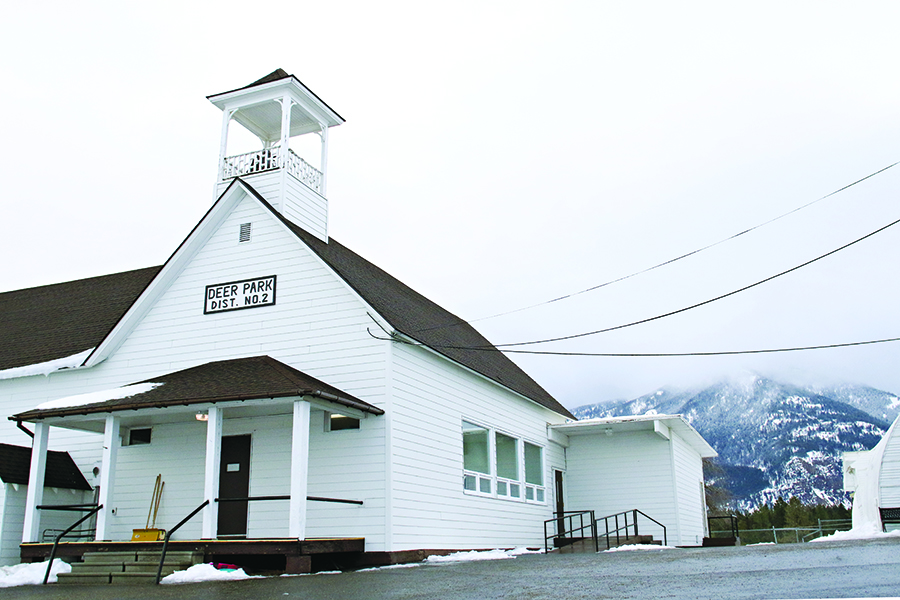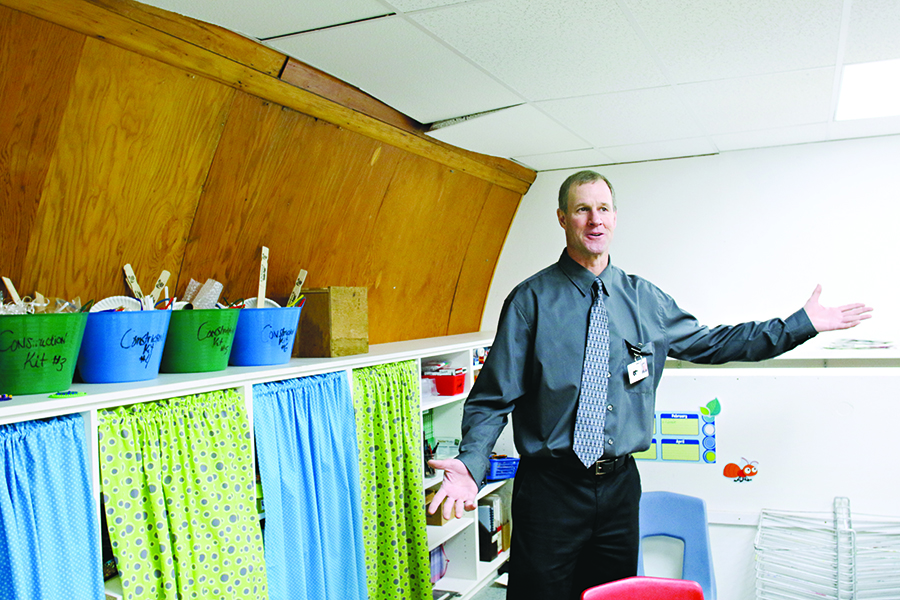In 133rd Year, Deer Park Strives to Preserve a Rural Academic Tradition
After a bond in September failed, officials are preparing to float a smaller one to address structural and crowding issues at county's oldest continually running school
By Myers Reece
On a winter morning at Deer Park School, in a small computer lab converted into a classroom, a few students are seated on footstools with workbooks on their laps, while others work in tightly clustered desks. The stools, generously called mini-benches, are an everyday reality because there’s not enough space for every kid to have a desk. These seventh-graders have adapted admirably, which could be said about everyone at the school, from the youngest children to teachers and administrators.
One boy, planted on a stool in the corner, offers an optimistic assessment.
“At least it’s really warm in here,” he tells a visitor.
Deer Park School, located in an agricultural area off Montana Highway 206 eight miles south of Columbia Falls, is the oldest continually running school in Flathead County, dating back to its formation in 1886. Its district number is “2,” meaning it was the second school established in the county. The long-defunct Demersville school district was the first.
As nearby rural schools have shut down over the years, Deer Park has become a haven for families, from both in and out of the district, seeking the small-school experience. Bad Rock School a few miles north shut down many years ago, and a farmer used it as a chicken house until it was demolished, leaving an empty field. A school in Hungry Horse also closed, eliminating one more rural option for families in the area.
All of which leaves Deer Park as an enduring community cornerstone, proudly upholding a rural academic tradition in a rapidly changing valley.
“This has been a special place to me,” Principal Dan Block said. “That’s why I’ve stayed here for 23 years.”
“We have really neat kids,” he added. “There’s a high-quality work ethic, and we’re like a big family here.”
As of October’s enrollment count, Deer Park currently serves 155 students in kindergarten through eighth grade, operating in a patchwork of buildings increasingly in need of substantial maintenance and expansion. Students, teachers and administrators have gotten creative to make the arrangement work, but school officials know adaptability isn’t a sustainable substitute for tackling the problems head on.
Last fall, as districts in Somers-Lakeside, Whitefish and Kalispell approved major packages for upgrades and new schools — worth $15.8 million, $26.5 million and $54 million, respectively — Deer Park came up short on a $3 million, 20-year bond that would have paid for facility upgrades, including tearing down a Quonset hut used as a classroom and connecting two other facilities, and addressed other issues. The last bond the school passed was in 1999 to fund the construction of a gymnasium.
Now school officials are preparing to float a scaled-down, $1.85 million proposal in May, hoping to finally address a growing litany of structural and overcrowding concerns.
The school’s rural nature is both an appealing trait for many families and a detriment to passing bonds. The valley’s population is booming, with growth occurring in Deer Park’s district as well, which increases student enrollment but doesn’t eliminate fundamental truths of the school’s location: In a district with a roughly two-mile radius, there are fewer homeowners paying into the property tax base than in a city or more densely populated rural area, and there’s not an abundance of high-end homes.
Furthermore, aside from a bar and greenhouse, there isn’t much in the way of industry in the district, which is a distinct entity from neighboring Kalispell and Columbia Falls school districts and is responsible for its own maintenance and budget.
Block, who started teaching at the school over 20 years ago and has been an administrator for the last seven, has spoken with taxpayers who voted against the bond and told him they want to support the school, and indeed cherish it, but the $315 property tax hike on a $200,000 home in September’s bond was simply too high. The new $1.85 million bond would cost taxpayers approximately $175 per year for a $200,000 property.
The school board will discuss the bond’s specifics and vote on a proposal to move forward at its next meeting on Feb. 13, after which Block expects to mail out ballots sometime in May.

Over the decades, Deer Park has expanded piecemeal with unconnected buildings, an arrangement that splits up classroom spaces and requires three separate septic tanks as well as multiple boilers. The original facility from 1886, a cabin, was upgraded to a schoolhouse with a bell tower in 1921 and is still in use. Staff members tug on a rope to ring the large bell at the end of recess.
In the early days, the school’s lone teacher and later two teachers lived in a small house on the property. Today the teacherage houses administrative offices and increasingly serves as storage as the school runs out of space, with every room from the bathroom to Block’s office accumulating items.
“We’re taking advantage of any space we have,” Block said.
A Quonset hut was built in the 1960s initially as a gym and now serves a variety of purposes, although it leaks in spots, and when ice builds up on the roof, tiles slip and shift. The music area is up front, with a small space off to the side reserved for counseling and other services. The back is a classroom. Teachers and students have grown accustomed to holding class while instruments reverberate from the adjacent music room.
“We’ll be doing algebraic equations to Itsy Bitsy Spider,” said Block, who is also an upper-grade math teacher, as well as the seventh- and eighth-grade basketball and cross country coach for boys and girls.
A newer classroom building was constructed in 1984 a stone’s throw from the bell tower building, the other primary class space. The modern gymnasium, added onto the 1984 structure, was completed in 2001. The gym doubles as the cafeteria, so it can’t be used for recess on days when the weather is too harsh to be outside. Kids instead play board games in their classrooms.
Nor does the school have a full kitchen. Twice a week, students get grab-and-go lunches, while the district partners with Columbia Falls to have hot lunches delivered the other three days.
Growing student enrollment in tight quarters means one-on-one interaction, such as individualized instruction or speech therapy, is conducted wherever there’s space, maybe the hallway or corner of the library, which Block said isn’t ideal. And there are only eight true classrooms for nine grades; expanding to nine full classrooms is a priority in the bond.
In order to scale back the new proposal, district officials are focusing on the most pressing issues while also trying to address long-term needs as best as possible within the tightened financial framework. For one, they are no longer asking to connect the two main classroom buildings but rather construct a pared-down addition on one. The idea is also to retire the Quonset hut, though Block doesn’t know if it would be torn down or used for storage.
“We can’t cut anything else (out of the bond) to meet the immediate needs while leaving a little room for expansion and growth,” Block said.
Gary Anderson, a school board member whose family has sent four generations of students to Deer Park, said the bond is crucial for the school’s ability to continue providing an optimal learning atmosphere.
“The number one goal is to teach the students and provide them with what they need to grow so they can go out in life and do the best they can do,” he said.
Not only is Deer Park the only school in the area, it’s also a community hub for residents of all stripes, even those who don’t have student-age kids. It has hosted, at no cost, events such as birthday parties, retirement bashes and funeral wakes, and its Christmas dinner drew 400 people. Generations of local families have attended school there.
“We’ve lost that in our society: the grange, the community centers, the places where the community can gather on regular basis, have barn dances and social events,” Anderson said.
“The leadership at Deer Park and board have strived to keep the school open as a community-event place where the community can gather and be a community,” Anderson added. “I think it’s important going forward in society as a whole that communities know each other and can help each other and support each other.”
Block enjoys opening up the gym to “help out and give back a little.”
“We have an incredible community here,” he said. “It’s kind of like Eastern Montana, where everyone steps up and helps out.”
Anderson’s grandmother attended Deer Park beginning in 1923, when students helped keep the wood-burning stove going in the winter and used outhouses. The outhouses were still in use when Anderson’s dad and uncles went to school in the late 1940s and 1950s. Through his time at Deer Park in the 1960s, Anderson had the luxury of indoor plumbing, as did his son years later.
Anderson has witnessed the school’s highs and lows, including when enrollment dropped to 57 during the recession in 2008 as families moved. The school couldn’t afford a librarian or all of its sports programs. Student numbers have nearly tripled since then, and Anderson says Deer Park has found an enrollment sweet spot, in which numbers are healthy but not so high as to diminish the small-school atmosphere. Now the kids just need the right infrastructure to carry them into the future.
“The school has touched a lot of lives over the years,” Anderson said. “A lot of families. A lot of generations.”